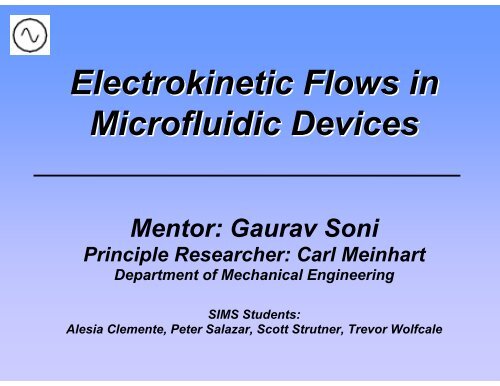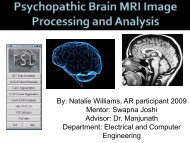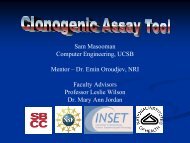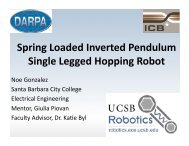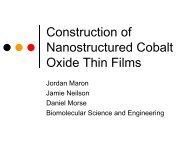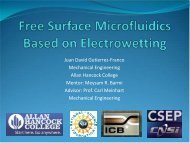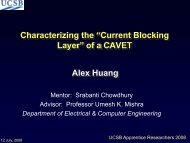Download Final Presentation
Download Final Presentation
Download Final Presentation
You also want an ePaper? Increase the reach of your titles
YUMPU automatically turns print PDFs into web optimized ePapers that Google loves.
Electrokinetic Flows in<br />
Microfluidic Devices<br />
Mentor: Gaurav Soni<br />
Principle Researcher: Carl Meinhart<br />
Department of Mechanical Engineering<br />
SIMS Students:<br />
Alesia Clemente, Peter Salazar, Scott Strutner, Trevor Wolfcale
Introduction<br />
Electrokinetics: The study of fluid flow under the<br />
influence of electric fields.<br />
• Medical<br />
• Rapid testing for Biological agents<br />
• 2 Days 30 minutes<br />
• Cheaper<br />
• Smaller samples size<br />
• Self contained test<br />
• Portability<br />
• User-friendly<br />
• Physically preserve biological elements
Research Goals<br />
• Transportation of micro fluids<br />
• Mixing of reagents<br />
• Pumping<br />
• Separation<br />
• Platelets<br />
• DNA<br />
• Research Goals:<br />
• Modelling fluidic flows on<br />
the micro scale when acted<br />
upon by electric fields<br />
• Mapping the velocity of micro<br />
flows<br />
Device on index finger
Device Geometry<br />
ICEO Flow<br />
chamber<br />
125 μm deep<br />
1 mm<br />
20 mm<br />
Gate Electrode<br />
200 μm wide<br />
10 mm<br />
Driving Electrodes
Induced Charge Electroosmosis<br />
(ICEO)<br />
•Electric fields induce charge density on metal surfaces<br />
+<br />
+ -<br />
-<br />
- + - +<br />
- +<br />
++++++++ ---------+++++++++ --------<br />
Driving<br />
Driving<br />
Electrode 1<br />
x<br />
Electrode 2<br />
L<br />
~ V 0<br />
Floating<br />
For ICEO, see Squires &<br />
Bazant, 2004
Induced Charge Electroosmosis<br />
(ICEO)<br />
+<br />
+ -<br />
-<br />
- + - +<br />
- +<br />
+ -<br />
++++++++ ---------+++++++++ --------<br />
Driving<br />
Driving<br />
Electrode 1<br />
x<br />
Electrode 2<br />
L<br />
~ V 0<br />
Floating<br />
For ICEO, see Squires &<br />
Bazant, 2004
Induced Charge Electroosmosis<br />
(ICEO)<br />
+ -<br />
- + - +<br />
-<br />
+ + - - +<br />
++++++++ ---------+++++++++ --------<br />
Driving<br />
Driving<br />
Electrode 1<br />
x<br />
Electrode 2<br />
L<br />
~ V 0<br />
Floating<br />
For ICEO, see Squires &<br />
Bazant, 2004
Induced Charge Electroosmosis<br />
(ICEO)<br />
+ -<br />
- + - +<br />
-<br />
+ + + - - - +<br />
++++++++ ---------+++++++++ --------<br />
Driving<br />
Driving<br />
Electrode 1<br />
x<br />
Electrode 2<br />
L<br />
~ V 0<br />
Floating<br />
For ICEO, see Squires &<br />
Bazant, 2004
Induced Charge Electroosmosis<br />
(ICEO)<br />
- + - +<br />
-<br />
+ + + + - - - - +<br />
++++++++ ---------+++++++++ --------<br />
Driving<br />
Driving<br />
Electrode 1<br />
x<br />
Electrode 2<br />
L<br />
~ V 0<br />
Floating<br />
For ICEO, see Squires &<br />
Bazant, 2004
Induced Charge Electroosmosis<br />
(ICEO)<br />
+ -<br />
- -<br />
+ + + + + - - - - - + +<br />
++++++++ ---------+++++++++ --------<br />
Driving<br />
Driving<br />
Electrode 1<br />
x<br />
Electrode 2<br />
L<br />
~ V 0<br />
Floating<br />
For ICEO, see Squires &<br />
Bazant, 2004
Induced Charge Electroosmosis<br />
(ICEO)<br />
•Electric fields induce charge density on metal surfaces<br />
•Induced charges cause electric double layer formation<br />
•Electric field becomes tangential<br />
- -<br />
+ + + + + + - - - - - - + +<br />
++++++++ ---------+++++++++ --------<br />
Driving<br />
Driving<br />
Electrode 1<br />
x<br />
Electrode 2<br />
L<br />
~ V 0<br />
Floating<br />
For ICEO, see Squires & Bazant, 2004
Induced Charge Electroosmosis<br />
(ICEO)<br />
Electric field sets the double layer in motion<br />
- -<br />
+ + + + + + - - - - - -<br />
+ +<br />
++++++++ ---------+++++++++ --------<br />
Driving<br />
Driving<br />
Electrode 1<br />
x<br />
Electrode 2<br />
L<br />
~<br />
V 0<br />
Floating<br />
For ICEO, see Squires & Bazant, 2004
Induced Charge Electroosmosis<br />
(ICEO)<br />
Electric field sets the double layer in motion<br />
- -<br />
+ + + + + + - - - - - -<br />
+ +<br />
++++++++ ---------+++++++++ --------<br />
Driving<br />
Driving<br />
Electrode 1<br />
x<br />
Electrode 2<br />
L<br />
~<br />
V 0<br />
Floating<br />
For ICEO, see Squires & Bazant, 2004
Induced Charge Electroosmosis<br />
(ICEO)<br />
Electric field sets the double layer in motion<br />
- + + + + + + - -<br />
- - - - -<br />
+ +<br />
++++++++ ---------+++++++++ --------<br />
Driving<br />
Driving<br />
Electrode 1<br />
x<br />
Electrode 2<br />
L<br />
~<br />
V 0<br />
Floating<br />
For ICEO, see Squires & Bazant, 2004
Induced Charge Electroosmosis<br />
(ICEO)<br />
Electric field sets the double layer in motion<br />
+<br />
-<br />
--<br />
+ + + + + +<br />
-<br />
- - - -<br />
+<br />
++++++++ ---------+++++++++ --------<br />
Driving<br />
Driving<br />
Electrode 1<br />
x<br />
Electrode 2<br />
L<br />
~<br />
V 0<br />
Floating<br />
For ICEO, see Squires & Bazant, 2004
Induced Charge Electroosmosis<br />
(ICEO)<br />
Electric field sets the double layer in motion<br />
+ -<br />
+ -<br />
-<br />
+ + + + -<br />
- - -<br />
+ +<br />
-<br />
++++++++ ---------+++++++++ --------<br />
Driving<br />
Driving<br />
Electrode 1<br />
x<br />
Electrode 2<br />
L<br />
~<br />
V 0<br />
Floating<br />
For ICEO, see Squires & Bazant, 2004
Induced Charge Electroosmosis<br />
(ICEO)<br />
Electric field sets the double layer in motion<br />
+ -<br />
+ -<br />
-<br />
+ -<br />
+ + + +<br />
-<br />
-<br />
- -<br />
+<br />
++++++++ ---------+++++++++ --------<br />
Driving<br />
Electrode 1<br />
L<br />
x<br />
Driving<br />
Electrode 2<br />
~<br />
V 0<br />
Floating<br />
For ICEO, see Squires & Bazant, 2004
Induced Charge Electroosmosis<br />
(ICEO)<br />
Electric field sets the double layer in motion<br />
+ -<br />
+ -<br />
+ -<br />
-<br />
+ -<br />
+ + +<br />
-<br />
- +<br />
-<br />
++++++++ ---------+++++++++ --------<br />
Driving<br />
Driving<br />
Electrode 1<br />
x<br />
Electrode 2<br />
L<br />
~<br />
V 0<br />
Floating<br />
For ICEO, see Squires & Bazant, 2004
Induced Charge Electroosmosis<br />
(ICEO)<br />
Electric field sets the double layer in motion<br />
- -<br />
L<br />
+<br />
+<br />
+ -<br />
+ -<br />
+ -<br />
+ -<br />
++++++++ ---------+++++++++ --------<br />
Driving<br />
Driving<br />
Electrode 1<br />
x<br />
Electrode 2<br />
-<br />
-<br />
+<br />
+<br />
~<br />
V 0<br />
Floating<br />
For ICEO, see Squires & Bazant, 2004
Induced Charge Electroosmosis<br />
(ICEO)<br />
Electric field sets the double layer in motion<br />
- -<br />
+<br />
+<br />
+<br />
+ -<br />
+ -<br />
+ -<br />
-<br />
-<br />
-<br />
+<br />
+<br />
++++++++ ---------+++++++++ --------<br />
Driving<br />
Driving<br />
Electrode 1<br />
x<br />
Electrode 2<br />
L<br />
~<br />
V 0<br />
Floating<br />
For ICEO, see Squires & Bazant, 2004
Induced Charge Electroosmosis<br />
(ICEO)<br />
Electric field sets the double layer in motion<br />
- -<br />
+<br />
+<br />
+<br />
+<br />
+ -<br />
+ -<br />
-<br />
- -<br />
-<br />
+ +<br />
++++++++ ---------+++++++++ --------<br />
Driving<br />
Driving<br />
Electrode 1<br />
x<br />
Electrode 2<br />
L<br />
~<br />
V 0<br />
Floating<br />
For ICEO, see Squires & Bazant, 2004
Induced Charge Electroosmosis<br />
(ICEO)<br />
Electric field sets the double layer in motion<br />
+ + + + +<br />
+ -<br />
-<br />
- - - -<br />
-<br />
-<br />
+ +<br />
++++++++ ---------+++++++++ --------<br />
Driving<br />
Driving<br />
Electrode 1<br />
x<br />
Electrode 2<br />
L<br />
~<br />
V 0<br />
Floating<br />
For ICEO, see Squires & Bazant, 2004
Induced Charge Electroosmosis<br />
(ICEO)<br />
Electric field sets the double layer in motion<br />
++++++++ ---------+++++++++ --------<br />
Driving<br />
Driving<br />
Electrode 1<br />
x<br />
Electrode 2<br />
L<br />
~ V 0<br />
Floating<br />
For ICEO, see Squires & Bazant, 2004
Wafer Manufacture<br />
•Clean wafer<br />
-Acetone bath<br />
•Apply photo resist<br />
-Even on<br />
centrifuge<br />
•Expose and develop<br />
-UV, Lay out<br />
design<br />
•Deposit Metal<br />
-300nm thick Gold<br />
•Lift off
<strong>Final</strong> Product
Epi-Fluorescent Microscope<br />
Excitation filter<br />
White light<br />
CCD<br />
Focusing lens<br />
Filter cube<br />
Computer<br />
with μPIV<br />
program<br />
Hg lamp<br />
Excitation light (λ=532nm)<br />
Objective lens<br />
Emitted light (λ=612nm)<br />
Fluorescent particle solution
ICEO EXPERIMENT<br />
1 mm<br />
200 μm<br />
Gate Electrode<br />
Driving electrode 1 Driving electrode 2<br />
~ V 0 =9 V max<br />
Floating<br />
10 mm
Micro Particle Image Velocimetry<br />
•Micro Particle image velocity<br />
• Two images, known Δt<br />
• Sectioning off<br />
• Comparing<br />
• Movement vector
Micro Particle Image Velocimetry<br />
•Micro Particle image velocity<br />
• Two images, known Δt<br />
• Sectioning off<br />
• Comparing<br />
• Movement vector
Micro Particle Image Velocimetry<br />
1 mm<br />
200 μm<br />
Gate Electrode<br />
Driving electrode 1 Driving electrode 2<br />
10 mm<br />
~<br />
Floating<br />
For μPIV, see Meinhart, Wereley & Santiago 1999
Horizontal Velocity Vector Field<br />
10μm<br />
sec
Results!<br />
•Ion filled fluids flow at an average of 10μm/sec<br />
•This is very fast for the micro scale<br />
•Fast enough for use in practical applications<br />
•The flows are in cyclic cycles
Thanks to…<br />
Army Research Lab (for funding)<br />
•<br />
CNSI (for this program)<br />
•<br />
NSF (for funding CNSI and SIMS)<br />
•<br />
UCSB (for hosting all this)<br />
•


